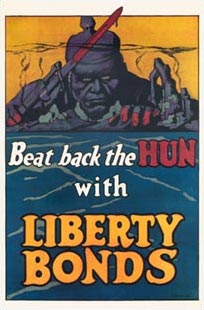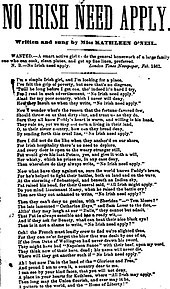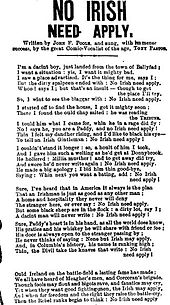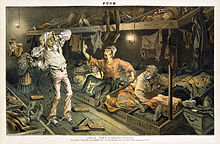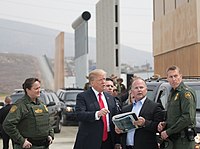
The Immigration Act of 1924, or Johnson–Reed Act, including the Asian Exclusion Act and National Origins Act, was a federal law that prevented immigration from Asia and set quotas on the number of immigrants from Eastern and Southern Europe. It also authorized the creation of the country's first formal border control service, the U.S. Border Patrol, and established a "consular control system" that allowed entry only to those who first obtained a visa from a U.S. consulate abroad.

Immigration reduction refers to a government and social policy in the United States that advocates a reduction in the amount of immigration allowed into the country. Steps advocated for reducing the numbers of immigrants include advocating stronger action to prevent illegal entry and illegal migration, and reductions in non-immigrant temporary work visas. Some advocate tightening the requirements for legal immigration requirements to reduce numbers or move the proportions of legal immigrants away from those on family reunification programs to skills-based criteria.

Anti-Italianism or Italophobia is a negative attitude regarding Italian people or people with Italian ancestry, often expressed through the use of prejudice, discrimination or stereotypes. Often stemming from xenophobia and anti-Catholic sentiment, it has manifested to varying degrees in a number of countries, notably the United States, Switzerland, Germany, Belgium and the United Kingdom. Its opposite is Italophilia, which is admiration of Italy, its people, and its culture.
The Order of the Star Spangled Banner (OSSB) was an oath-bound secret society in New York City. It was created in 1849 by Charles B. Allen to protest the rise of Irish and German Catholic immigration into the United States.
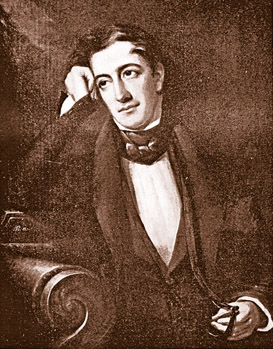
Lewis Charles Levin was an American politician, newspaper editor and anti-Catholic social activist. He was one of the founders of the American Party in 1842 and served as a member of the U. S. House of Representatives representing Pennsylvania's 1st congressional district from 1845 to 1851. Levin was the second person of Jewish descent elected to the United States Congress after David Levy Yulee.

The American Republican Party was a minor anti-Catholic, anti-immigration, and nativist political organization that was launched in New York in June 1843, largely as a protest against immigrant voters and officeholders.
Opposition to immigration, also known as anti-immigration, is a political ideology that seeks to restrict the incoming of people from one area to another. In the modern sense, immigration refers to the entry of people from one state or territory into another state or territory in which they are not citizens in contrast, but closely correspond to emigration which refers people leaving one state or territory in which they are citizens. Illegal immigration occurs when people immigrate to a country without having official permission to do so. Opposition to immigration ranges from calls for various immigration reforms, to proposals to completely restrict immigration, to calls for repatriation of existing immigrants.

The Know Nothings were a nativist political movement in the United States in the 1850s, officially known as the Native American Party before 1855, and afterwards simply the American Party. Members of the movement were required to say "I know nothing" whenever they were asked about its specifics by outsiders, providing the group with its colloquial name.
Anti-Catholicism in the United States concerns the anti-Catholic attitudes which were first brought to the Thirteen Colonies by Protestant European settlers, mostly composed of English Puritans, during the British colonization of North America. Two types of anti-Catholic rhetoric existed in colonial society and they continued to exist during the following centuries. The first type, derived from the theological heritage of the Protestant Reformation and the European wars of religion, consisted of the biblical Anti-Christ and the Whore of Babylon variety and it dominated anti-Catholic thought until the late 17th century. The second type was a variety which was partially derived from xenophobic, ethnocentric, nativist, and racist sentiments and distrust of increasing waves of Catholic immigrants, particularly immigrants from Ireland, Italy, Poland, Germany, Austria and Mexico. It usually focused on the pope's control of bishops, priests, and deacons.

The history of immigration to the United States details the movement of people to the United States from the colonial era to the present day. Throughout U.S. history, the country experienced successive waves of immigration, particularly from Europe and later on from Asia and Latin America. Colonial-era immigrants often repaid the cost of transoceanic transportation by becoming indentured servants in which the new employer paid the ship's captain. In the late 19th century, immigration from China and Japan was restricted. In the 1920s, restrictive immigration quotas were imposed but political refugees had special status. Numerical restrictions ended in 1965. In recent years, the largest numbers of immigrants to the United States have come from Asia and Central America.
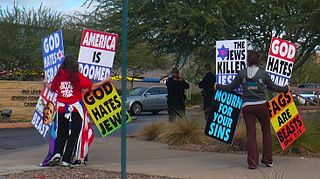
Antisemitism has long existed in the United States. Most Jewish community relations agencies in the United States draw distinctions between antisemitism, which is measured in terms of attitudes and behaviors, and the security and status of American Jews, which are both measured by the occurrence of specific incidents.
Nativism is the political policy of promoting or protecting the interests of "native-born" or established inhabitants over those of immigrants, including the support of anti-immigration and immigration-restriction measures. In the United States, nativism does not refer to a movement led by Indigenous peoples, also called Native Americans or Indians.
American ancestry refers to people in the United States who self-identify their ancestral origin or descent as "American", rather than the more common officially recognized racial and ethnic groups that make up the bulk of the American people. The majority of these respondents are visibly White Americans, who are far removed from and no longer self-identify with their original ethnic ancestral origins. The latter response is attributed to a multitude of generational distance from ancestral lineages, and these tend be Anglo-Americans of English, Scotch-Irish, Welsh, Scottish or other British ancestries, as demographers have observed that those ancestries tend to be recently undercounted in U.S. Census Bureau American Community Survey ancestry self-reporting estimates.
In 1800 the Catholics were a small minority everywhere except Maryland. Immigration from Ireland and Germany gave them millions of adherents from the 1840s to the 1880s. Then came millions more from Italy, Poland and Eastern Europe, as well as French Canada. Large numbers of priests and nuns came from Ireland and France. The Irish soon dominated the clergy church, with a great majority of bishops by 1900. As the immigrants arrived new parishes and diocese were created. Rebuffed in efforts to obtain government funds for schools, the Catholics set up a parochial school system largely staffed with nuns. It reached about a third of the children. They also set up colleges. There were few Catholics in the South, apart from Louisiana. However they were well represented in the nation's cities, mill towns and mining centers. Anti-Catholic politics flared briefly in the 1850s, but the Catholic voters surged into the Democratic Party and Irish Catholic politicians played increasingly dominant roles in Democratic machines in Boston, New York, and other major cities. Devotional practices included daily rosary prayers, regular attendance at Sunday Mass, and special roles for devotion to the Blessed Virgin Mary and favorite saints.
In the politics of the United States, the radical right is a political preference that leans towards ultraconservatism, white nationalism, white supremacy, or other far-right ideologies in a hierarchical structure which is paired with conspiratorial rhetoric alongside traditionalist and reactionary aspirations. The term was first used by social scientists in the 1950s regarding small groups such as the John Birch Society in the United States, and since then it has been applied to similar groups worldwide. The term "radical" was applied to the groups because they sought to make fundamental changes within institutions and remove persons and institutions that threatened their values or economic interests from political life.
Ethnocultural politics in the United States refers to the pattern of certain cultural or religious groups to vote heavily for one party. Groups can be based on ethnicity, race or religion or on overlapping categories. In the Southern United States, race was the determining factor. Each of the two major parties was a coalition of ethnoreligious groups in the Second Party System as well as the Third Party System.

Xenophobia in the United States is the fear or hatred of any cultural group in the United States which is perceived as being foreign or strange or un-American. It expresses a conflict between an ingroup and an outgroup and may manifest in suspicion by the one of the other's activities, and beliefs and goals. It includes a desire to eliminate their presence, and fear of losing national, ethnic, or racial identity and is often closely linked to racism and discrimination.
Immigrant invasion—or similar phrases that imply that "immigrants are invading the homeland", is a rhetoric that is allegedly used by those who favor nativist, nationalist, and sometimes racist or xenophobic policies.
Zionist antisemitism or antisemitic Zionism refers to a phenomenon in which antisemites express support for Zionism and the State of Israel. In some cases, this support may be promoted for explicitly antisemitic reasons. Historically, this type of antisemitism has been most notable among Christian Zionists, who may perpetrate religious antisemitism while being outspoken in their support for Jewish sovereignty in Israel due to their interpretation of Christian eschatology. Similarly, people who identify with the political far-right, particularly in Europe and the United States, may support the Zionist movement because they seek to expel Jews from their country and see Zionism as the least complicated method of achieving this goal and satisfying their racial antisemitism.

The term Know-Nothing Riot has been used to refer to a number of political uprisings of the Know Nothing Party in the United States of the mid-19th century. These anti-immigrant and anti-Catholic protests culminated into riots in Philadelphia in 1844; St. Louis in 1854, Cincinnati and Louisville in 1855; Baltimore in 1856; Washington, D.C., and New York City in 1857; and New Orleans in 1858.


